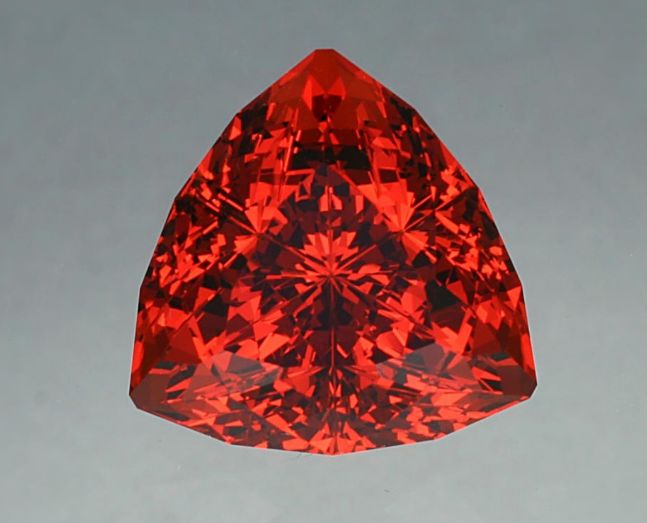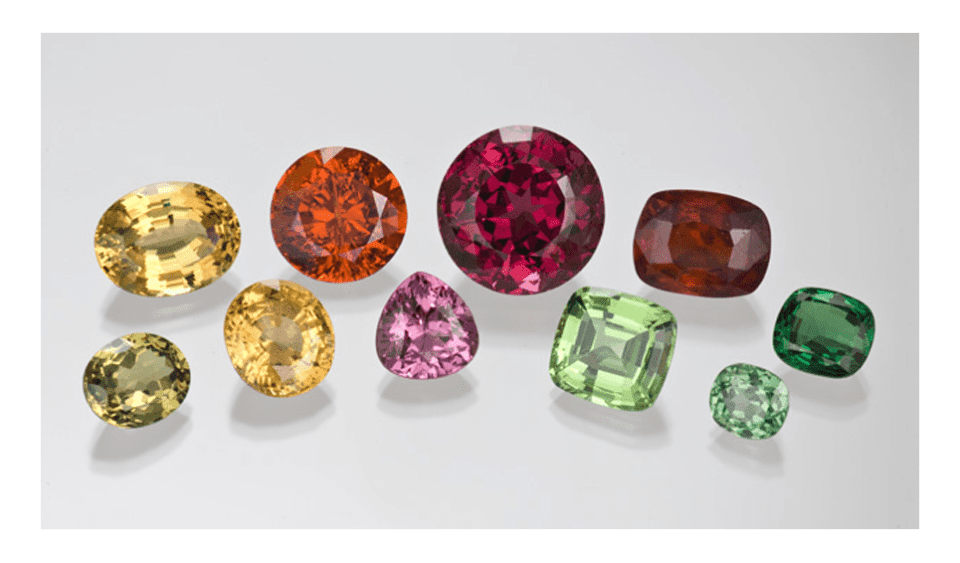Garnets are a group of closely related minerals that together form a gemstone family. This family of gemstones covers almost every color in the spectrum.

About Garnet
Minerals: Garnet group
Chemical compositions:
- Almandine: Fe₃Al₂(SiO₄)₃
- Andradite: Ca₃Fe₂(SiO₄)₃
- Grossular: Ca₃Al₂(SiO₄)₃
- Pyrope: Mg₃Al₂(SiO₄)₃
- Intermediate (Pyrope-Almandine): (Mg, Fe)₃Al₂(SiO₄)₃
- Spessartine: Mn₃Al₂(SiO₄)₃
Color: Found in virtually every color
Refractive Index: 1.714–1.888
Birefringence: None
Specific Gravity: 3.47–4.15
Mohs Hardness: 6.5–7.5
Garnet is a fascinating family of minerals, each with its own unique chemistry and captivating range of colors.

While red garnets have a long history, modern gemstone buyers can now choose from a much wider range of colors, including green, orange, pink-orange, deep, saturated purplish-red, and even blue.
Red garnet is one of the most common and widely found gemstones, found in metamorphic rocks across all continents (rocks altered by heat and pressure). However, not all garnets are as abundant as red garnets. One rare variety, the green garnet—Tsavorite, forms in metamorphic rocks but is rare due to the unusual rock chemistry and specific conditions required for its formation.
Garnet’s Rich Historical Legacy

(Collection of the National Museum of Natural History, Smithsonian Institution
Photographer: Chip Clark, Courtesy of the Smithsonian Institution)
Thousands of years ago, red garnet necklaces adorned the necks of Egyptian pharaohs as decorative symbols and precious possessions to accompany them into the afterlife, buried alongside their mummified remains. In ancient Rome, garnet-carved signet rings were used to seal important documents.
In antiquity, the term “ruby” often referred to red garnet, though it also described virtually any red gemstone. Cabochon-cut red garnets, known as carbuncles, were considered one of the four great gemstones gifted by God to King Solomon.
By the time of Roman scholar Pliny (AD 23–79), red garnet had become one of the most widely traded gemstones. During the Middle Ages (circa AD 475–1450), red garnets were highly prized by clergy and nobility.
Around 1500, the discovery of the famous Bohemian garnet deposits in Central Europe made red garnet much more accessible. By the late 19th century, this region became the center of a flourishing jewelry industry, reaching its peak in prominence and craftsmanship.
Garnet Buyer’s Guide
Color:
Color is the most important factor when evaluating garnet. Here’s how some of the main garnet varieties differ in color:
- Pyrope and Almandine Garnet: Their color ranges from purple to orange-red.
- Spessartine Garnet: Known for its vibrant range of orange hues.
- Andradite Garnet: Occurs in yellow to green tones.
- Grossular Garnet: Has a remarkably broad color range—colorless, yellow, red-orange, orange-red, and bright, vivid green.
The wide spectrum of garnet colors ensures that there’s a beautiful gem for every taste and style.

(Tsavorite is a striking green to yellow-green garnet. These gems are cut from a single rough stone, with the largest known gem weighing 23.23 carats.
Courtesy of Menavi Quality Cut Ltd.)

(This striking 11.35-carat triangular-cut spessartine garnet captivates with its precision and symmetry, exceptional clarity, and a fiery, saturated orange-red hue—truly a wonder to behold. Courtesy of John Dyer & Co.)

(A mix of pyrope and almandine garnet, this variety usually appears as a dark red—the most common color of garnet.© GIA & Tino Hammid, courtesy of Varujan Arslanyan.)
Clarity&Inclusions:
The typical clarity of garnet depends on its variety:
- Red almandine, pyrope, and pyrope-almandine garnets are generally free of eye-visible inclusions.
- Certain orange garnets, such as spessartine and hessonite, usually contain inclusions that can be seen with the naked eye.

Cut:
Cutting is crucial to a garnet’s appearance. Many garnets are cut into standard shapes and sizes for easier jewelry setting, especially for red garnets.
For more valuable garnets (like top-quality Tsavorite), cutters aim to maximize yield from the rough while ensuring a pleasing shape and style.

Garnets come in a wide range of shapes and cutting styles, offering buyers plenty of options to suit their taste and jewelry designs.

Garnet does not display pleochroism (color change in different crystal directions), so cutters don’t need to worry about orienting the stone for color like they would with other gems.
Overall, Garnet is a versatile and colorful gemstone group, offers a wide range of vibrant hues, impressive clarity, and diverse cutting styles, making it a popular and enduring choice for jewelry.


